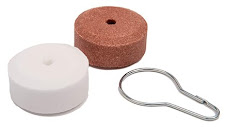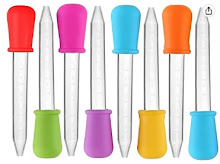Tammie bought one of my Silver Fox rabbit kits yesterday for her daughter's birthday today. As a new rabbit grandma, she was curious as to what supplies I would suggest. I sent her the following links. These are products I use and recommend. I have been using these exact supplies for many years as I housed my French Angora and pet rabbits inside my home. I still use the large cages for kindling. My Americans, Silver Foxes, and French Angoras are large breed rabbits and require large cages. Even these cages below aren't big enough for really great exercise, but inside/pet bunnies get a lot of out-of-cage play time, so that makes up for it.
This post is not related to commercial rabbitry. [Contains Affiliate Links]
I prefer this cage or one very similar that is available at the feed stores. The flat top means that I can stack them, or stack things on top of them, if I need to. We have had them stacked three high with no issues. The base is deep to hold in bedding and poo, and to splash guard some for male rabbits who like to pee in the corners. I still suggest that you zip tie some plexiglass or other barrier in the corner where they pee if it becomes an issue. I do not use that little plastic shelf for the rabbits. It's more for guinea pigs or little rabbits to give them a hidey hole under it. It just gets in the way for large rabbits.
If you want to provide even more space, this is a more deluxe version.
This is a similar cage but with a rounded top. Again, for my purposes, I prefer the flat tops, and rabbits don't need extra height, but it's still a great option.
I prefer these wide mouthed waterers that hold a lot. They are much easier to fill and clean. I sanitize my waterers once a month with a mild vinegar solution of just a splash of vinegar to a bottle half full of water. Shake it around, then pour it out all over the lid and nipple. Rinse very well before refilling.
In theory, I actually prefer the ones that you can take off the lid and fill without removing, but I've had horrible luck with them and they just don't work. I've tried many different kinds of water bottles and these have worked the best for me.
Rabbits chew plastic up quickly. A metal feeder is the way to go. I do not ration my feed, so I just keep these filled at all times. Rabbits will choose what they need to eat, and will almost always go for hay over pellets.
Speaking of hay, this is one item I have not purchased. I built hay feeders onto my current cages, but they go through it so quick I just pile hay in with them. I did the same when I had rabbits in the cages above. But, for home use, if you want a hay feeder, this one is metal and has a nice back to help keep the hay in the cage.
They also need salt and mineral blocks available. They don't use them often if provided a good diet, but when they do extra salt or minerals, these need to be there.
You need to keep their nails trimmed. This can be difficult with dark nailed rabbits, so I like these clippers because you can set the metal backing and just clip a bit off at a time and are protected from going too deep all at once.
And in case you DO go too deep, always have some styptic powder on hand to stop the bleeding.
Rabbits need a good quality hay as 70% of their diet, so it is important that they always have a great supply available. While most items above you aren't going to find much cheaper locally versus Amazon, hay will definitely be cheaper at your local feed store. I highly suggest buying a bale there and keeping it in a large black trashbag once you get it home. Timothy has a lot of hay "dust" that can be incorporated into their feed in their feeder so it isn't wasted.

As with the hay, rabbit pellets will be much cheaper bought from your local feed store. Some rabbit owners ration pellets to 1/4 cup a day. I just keep them stocked with hay and pellets and provide fruits and veggies daily so that they can eat what they need. I've never had an overweight rabbit. If they keep active and have plenty of out-of-cage time to explore, they will stay fit. If your rabbit starts to become overweight, then it is time to ration pellets. I have large rabbits, so the small pet rabbit packages of pellets just don't work. You will pay much more than just getting a 40-50lb. bag at your feed store. If worried about mice, keeping feed in metal trash cans or a locking tote is your best option.

While we could discuss treats and toys, really the last thing you need to WORRY about is keeping their teeth filed. Rabbits where meant to chew and they NEED to chew. While you can buy something like this, really any piece of untreated wood or even a good piece of branch from your back yard will work, but they need to have a piece of wood to gnaw on to keep their teeth from getting too long.
So there you go with the must-haves of owning a pet rabbit. I will add two things that I LOVE.
These large droppers for adding oil to their ears to get rid of ear mites.
And this scoop for cleaning out the cages.
Rabbits are one of the best pets you can own. They can be easily contained, are quiet, have a simple diet, bathe themselves, only need an occassional nail clipping for grooming, and are sweet and affectionate. Their poop makes the most amazing compost for your garden and they are great at eating up all those left over fruits and veggies. Win. Win. Enjoy your new amazing family member!
And remember, JCFS's livestock policy allows for any animal bought from JCFS to be returned to JCFS at any time, for any reason, without a refund. If you feel you must surrender your animal, we prefer it to be returned to us.












































.jpg)
.jpg)


